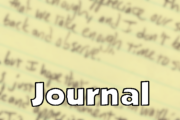Obviously, the date and time would be too useful to display…
6 minute read
December 19, 2010, 1:59 AM
Coming back from a Christmas shindig in Northern Virginia this evening, I encountered this sign on the Beltway:

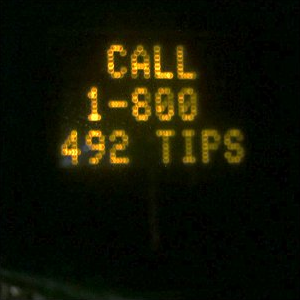
Basically, the sign encourages people to report “terror tips” to the authorities at the aforementioned number. A little research indicates that the number goes to the Maryland Coordination and Analysis Center, a state counter-terrorism agency.
This particular sign was one of those portable signs – the kind like this. This one, for those interested, is located on the Inner Loop in Maryland, about a mile or so before the I-270 split on the right side of the road.
There are also similar messages posted elsewhere in the state on the permanent overhead message signs. In those cases, the message is “REPORT SUSPICIOUS ACTIVITY” along with the phone number. I’ve seen that message on the Outer Loop near that side’s I-270 split, as well as on I-270 and I-70. These messages have been running since at least early November.
Interestingly enough, DC started running similar messages around the same time on their message signs, encouraging people to report suspicious activity and providing a number for the MPDC. Virginia doesn’t seem to have gotten into the act on this, as I’ve not seen any of these kinds of messages on signs in Virginia. Presumably, Virginia is a bit preoccupied with fighting against health care right now, and thus doesn’t need to advertise that they need help finding something to do.
The problem with the messages on these signs, in my opinion, is that they are encouraging people to rat out their neighbors. If you suspect something is “up”, call this tip line. The problem is, as Bruce Schneier (my hero as of late) has said, if you get amateurs to be your front line security personnel, you get amateur results (see Schneier’s essay on this). Ordinary people aren’t trained to recognize suspicious activity, and people are all too willing to roll over and do whatever the government tells them (because what the government tells you, especially when coming out of the mouths of elected officials, is not necessarily always in your own best interest). And let’s also not forget that somehow I often end up getting the business end of this when going about my business.
Let’s be honest – I’ve been reported or stopped many times due to photography. Realize that in today’s wet-your-pants-over-anything-that-could-be-even-remotely-construed-as-terrorism society, my digital camera automatically makes me a card-carrying terrorist. It doesn’t matter that photography in and of itself is legal. It doesn’t matter that I am carrying out my activities from a public area and photographing things that are in plain view from public areas. By taking pictures, apparently I am a terrorist. Let’s review some of the photography that has gotten me in trouble over the years:
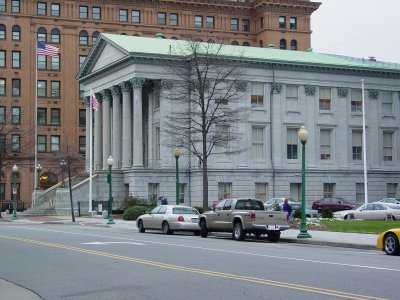
Photo of the Owen B. Pickett U.S. Custom House in Norfolk, Virginia, taken on March 11, 2003. I photographed the building for its architecture. I was stopped on the street by a federal officer who questioned me as to why I was taking photos, where I was from, why I was in Norfolk, what I did for a living, and even asked me directly whether or not I was a terrorist. Apparently it wasn’t obvious enough that I was a photographer, considering the camera bag and tripod bag that I was carrying on my person. And the ironic thing is that this wasn’t even a good photo that I got harrassed for. My Norfolk trip was planned well in advance and I couldn’t control the weather (and was quite disappointed about it being overcast). But apparently, it was enough to make this federal officer wet his pants. Partly due to this incident, I have not been back to Norfolk since, and currently have no plans to return.
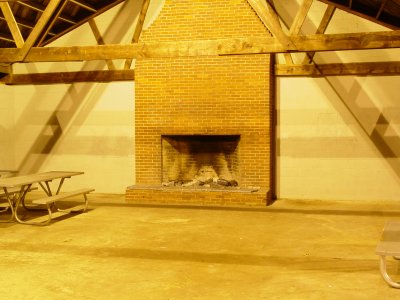
Long-exposure photograph of a fireplace at McIntire Park in Charlottesville, Virginia, photographed on December 25, 2003. Part of a photo set, though this photo was not used. No less than three cop cars came to greet me on this one after a citizen’s tip to police. Apparently someone with a camera on a tripod (and with a crummy zoom lens at that) just has to be up to no good. I don’t think it ever crossed the caller’s mind that someone photographing with a tripod in a park at night might actually be – get this – photographing the park. I know, pretty radical concept. The cops, however, figured out pretty quickly that there was nothing to see, but asked that I leave the park due to the time of day. The signs posted in the park said that the park was open until 10 PM, and it was around 9 PM. The cops said the park closed at sunset. I wasn’t in the mood to argue with them, and so I packed up my gear and left. I still got a decent photo set out of it, though.
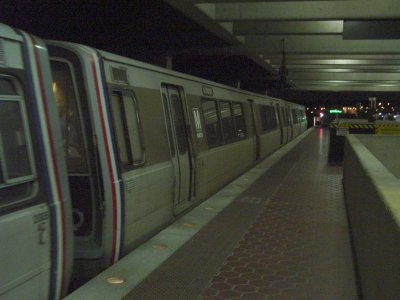
WMATA Money Train at Huntington, photographed on August 31, 2005. Taken because I am a railfan. A few employees figuratively wet their pants when they saw me photographing a train in plain view from a publicly-accessible area of the system (oh, heavens!). They called a supervisor, who took me into the little booth at the end of the platform while he made a phone call. Supervisor called Central Control, and Central Control called Transit Police. Okay. Transit Police came over, realized that there was nothing to see, and we ended up talking about digital cameras while I waited for the next train. Something tells me that Metro needed to better educate their employees that people with cameras are not a threat. Additionally, if the supervisor really thought that I was such a huge threat, why did he take me into a non-public area with lots of equipment involved in running the rail system? I could have had a lot of fun with that if I were truly intent on causing chaos. I think if that situation were repeated today, I probably would have had a little fun with the camera in the little booth, and photographed everything in there, in detail. Just to be an ass. If he had any objections, I would have said, “Well, you shouldn’t have let me in here, now, eh?” And I do not delete photos. Those would have gone up on Transit Center, that’s for sure.
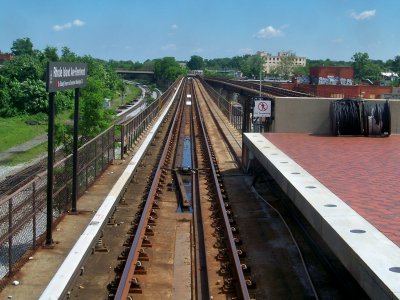
Railfanning, June 1, 2008. A random Metro employee saw me photographing out the window, wet his pants, called Transit Police, and I got pulled off the train by two Transit Police officers for questioning. They again figured out, like so many before them, that there was nothing to see, though they tried a little BS-ing on their part to justify themselves, likely because they knew there was nothing going on.
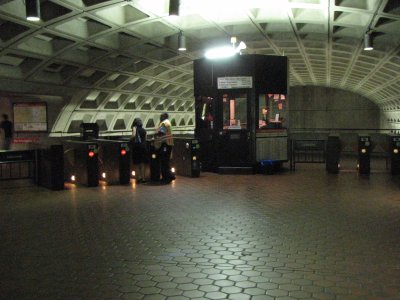
Railfanning, May 1, 2010. In the time since the last confrontation, I had read up on my rights, and was determined to not get pushed around. I was with Matthew on this one, and obviously the employee in the picture wet his pants when he saw my camera, because when Matthew and I returned to the station, a supervisor was waiting for me. He tried to pull the terrorism card with me, and I came back swinging (figuratively speaking). He ultimately backed off, because I think he realized I had him over a barrel.
Except for the one case where the federal officer witnessed my photography directly (and should have known better), it was all people with the “see it, say it” mentality who saw my camera and wet their pants. All of it a waste of the police officers’ time and your tax dollars. And it’s signs like the ones described at the top of this entry that perpetuate this wasting of people’s time. The signs are security theater, plain and simple, and apparently they’re being used as filler, since apparently there’s nothing about traffic or road conditions to report. Apparently something sane like displaying the date and time or simply letting the signs be dark (and saving energy) would make too much sense, and so Maryland and DC have chosen to “keep fear alive” with these counterterrorism messages. This just seems to give people more motivation to report people for doing things that they are entirely within their rights to do. Basically, if it makes them wet their pants for any reason, it must be foul play, and the police must be notified, because apparently, ratting out your fellow citizens over lawful activity is patriotic or something.
However, if you know your rights, and come out swinging in asserting them, you normally can come out on top.
Song: Nothing...
Quote: And in the case of most security theater, this actually makes us less safe. These signs were intended for traffic alerts and such, and their being powered on and with a message in and of itself should be enough to draw our attention to it, because it means something is up. If it's always on with a counter-terrorism message, we become accustomed to seeing it on, and therefore it may not necessarily register that the message has changed, alerting us to danger ahead or something else with actual consequences.
Categories: Driving, Photography, Security, WMATA








